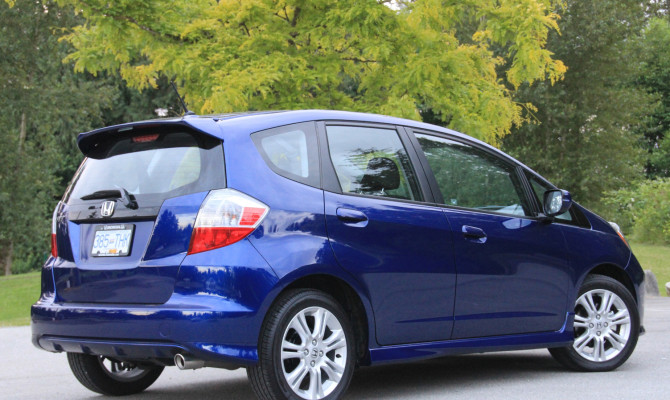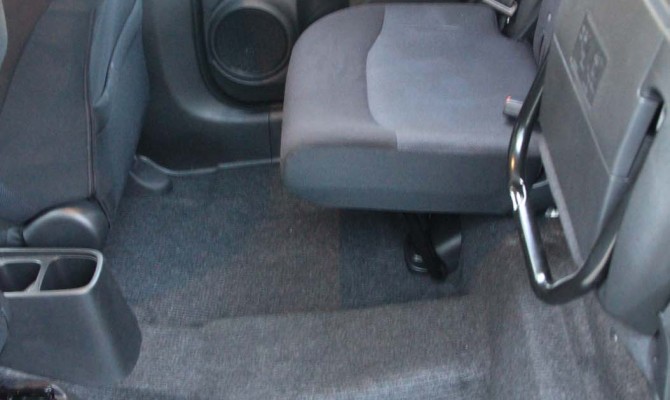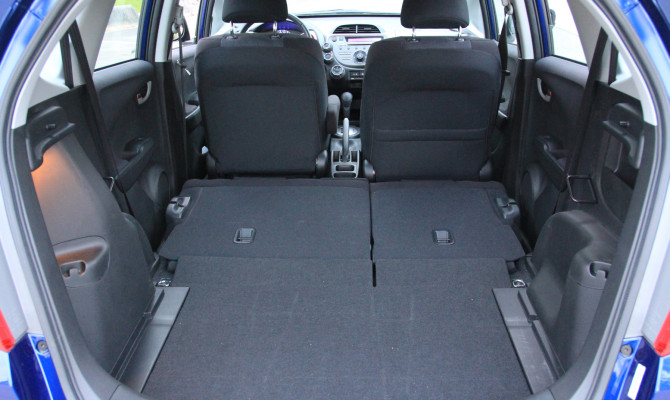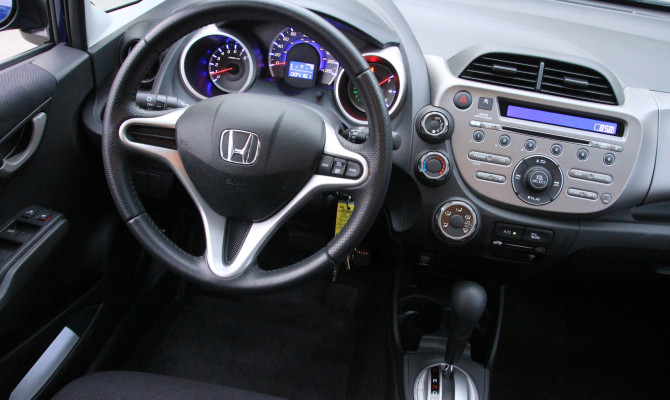“Fit offers excellent gas consumption, agile handling and zippy performance…”
The Honda Fit is a highly versatile 5-door subcompact hatchback.
It was introduced to Canadians in 2006 as a 2007 model and sells in other parts of world as the Honda Jazz. Like most good subcompacts, Fit offers excellent gas consumption, agile handling and zippy performance. A clever design, however, allows an owner to fit more stuff in a Fit than seems possible and it comes with an excellent occupant protection safety package.
The gas tank in a Fit is positioned further forward to allow a low, flat cargo floor in the rear and its seating can contort to a multitude of setups, to accommodate all kinds of cargo. Its rear side doors also open extra wide, making it easier to get that stuff in or out. There’s ample headroom for tall occupants and Fit’s cabin feels more spacious than most in this class.
The second-generation ’09 redesign gave Fit a more rigid and slightly longer body with even more passenger cabin space; an increase in engine power and this Fit is (marginally) more fuel-efficient. The extra inner space was achieved by positioning the front pillars further forward. Rear passengers benefited most with increased leg and headroom.
Fit comes in three trim levels; DX, LX and a top-line Sport edition. All trims are powered by the same 117-horsepower 1.5-litre engine and come standard with six airbags and anti-lock (ABS) brakes. The top-line Fit Sport adds a 160-watt premium audio system, keyless entry, fog lights, a rear roofline spoiler, cruise control, a leather-wrapped steering wheel, 15-inch alloy wheels and an aero under-body kit,.
Interestingly, the auto transmission versions come with a tire inflation kit instead of a spare wheel. It was a weight-reduction measure that also adds some extra storage space. A proper (conventional) spare wheel was offered as an option for the original owner.
Although it’s certainly not limited to being an urban runabout as Fit is surprisingly stable on the highway, considering its short wheelbase and trim, tall-ish body. Yet, some will probably find the high-speed cabin noise level and Fit’s taut ride a little tiresome on a long road trip.
Mechanical reliability is excellent and city/highway fuel economy is roughly the same with the base five-speed manual transmission or optional five-speed automatic. Using the new five-cycle rating method, an ’09 Fit with an automatic should consume 8.3 litres every 100 km when driven in the city and 6.6 litres every 100 km on the highway.
The only significant production change to the second generation Fit came for the 2011 model year when an electronic stability control system was included as a standard feature on the Sport edition. It was optional on other editions and it’s definitely a very good handling enhancing safety feature.
Popular cars sell at premium resale prices and the second generation Honda Fit is a prime example. Beware of imports from the east (do an ownership history check) as corrosion and road salt issues are a concern. If you’re paying a premium price, make sure it’s a primo Honda Fit.
Price Check: 2009 – 2014 Honda Fit (April 2015)
Year Edition Expect to Pay Today
2009 LX $7,500 to $10,000
2010 LX $8,500 to $11,500
2011 LX $10,000 to $13,000
2012 LX $11,500 to $14,500
2013 LX $13,000 to $16,000
2014 LX $15,000 to $18,000
Prices vary depending on a used vehicle’s condition, mileage, usage and history. A complete mechanical check should always be performed by a reliable auto technician prior to purchase.
Safety Recalls: 2009 to 2014 Honda Fit:
2009/2010: A spring in the lost motion spring assemblies of the engine’s variable valve timing and lift electronic control (VTEC) system may bind and fracture. This could potentially cause the engine to stall, without the ability to restart. Dealers will inspect and, if necessary, replace the four lost motion spring assemblies.
2012/2013: The Vehicle Stability Assist (VSA) system may sporadically stop functioning as intended. Dealers will reprogram the Vehicle Stability Assist software.
2013/2014: The passenger side driveshaft could fracture and separate. Dealers will replace affected driveshafts.
Recent Comments
- { Enjoyed your Forest of Bowland in the BMW X5M, particularly the photo of the BMW in front of the main part of Stonyhurst College where... }
- { Bantam designed the Jeep, not Willy's or Ford. The American military gave the original Bantam prototype to Willys and Ford to copy. There is plenty... }
- { All Escalades come with a 6.2-lilter V8 engine that produces 420 horsepower. A six-speed automatic is the only transmission offered and drives the rear wheels.... }
- { Alexandra is an excellent journalist. }
Popular Posts
- Journey to a ‘Sparkling’ Luxury Okanagan Resort “Four lucky readers will put a Dodge Journey’s weekend-...
- The Need For Speed: Hike Those Highway Limits More than half of those polled believe the province sho...
- Drives-U-Crazy… Erratic drivers. An early morning drive from Kelowna to Vancouver is nor...
- Readers Respond: The Pros and Cons of Increasing B.C. Speed Limits Increasing the speed limits will only increase risk to...
- Honda CR-V Review: The Compact Crossover To Get Things Done The CRV is a very stylish and aerodynamic crossover veh...










